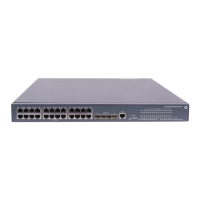177
The switch determines whether a received frame carries a VLAN tag by checking the TPID value. For
example, if a frame carries a VLAN tag with TPID value 0x8100, but the configured TPID value is 0x9100,
the switch considers that the frame does not carry any VLAN tag.
Devices of different vendors may set the TPID of the outer VLAN tag of QinQ frames to different values.
For compatibility with these devices, modify the TPID value so that the QinQ frames, when sent to the
public network, carry the TPID value identical to the value of a particular vendor, allowing
interoperability with the devices of that vendor.
The TPID in an Ethernet frame has the same position as the protocol type field in a frame without a VLAN
tag. To avoid problems in packet forwarding and handling in the network, do not set the TPID value to
any of the reserved values.
Table 20 Reserved protocol type values
Protocol t
e Value
ARP 0x0806
PUP 0x0200
RARP 0x8035
IP 0x0800
IPv6 0x86DD
PPPoE 0x8863/0x8864
MPLS 0x8847/0x8848
IPX/SPX 0x8137
IS-IS 0x8000
LACP 0x8809
802.1X 0x888E
Cluster 0x88A7
Reserved 0xFFFD/0xFFFE/0xFFFF
Protocols and standards
IEEE 802.1Q: IEEE standard for local and metropolitan area networks: Virtual Bridged Local Area
Networks
QinQ configuration task list
When you configure QinQ, follow these guidelines:
• QinQ requires configurations only on the service provider network.
• QinQ configurations made in Ethernet interface view take effect on the current interface only. Those
made in Layer 2 aggregate interface view take effect on the current aggregate interface and all the
member ports in the aggregation group. Those made in port group view take effect on all member
ports in the current port group.
• Do not configure QinQ on a reflector port. For more information about reflector ports, see Network
Management and Monitoring Configuration Guide.

